sensor TOYOTA PRIUS PRIME 2023 Owner's Manual
[x] Cancel search | Manufacturer: TOYOTA, Model Year: 2023, Model line: PRIUS PRIME, Model: TOYOTA PRIUS PRIME 2023Pages: 680, PDF Size: 14.97 MB
Page 285 of 680
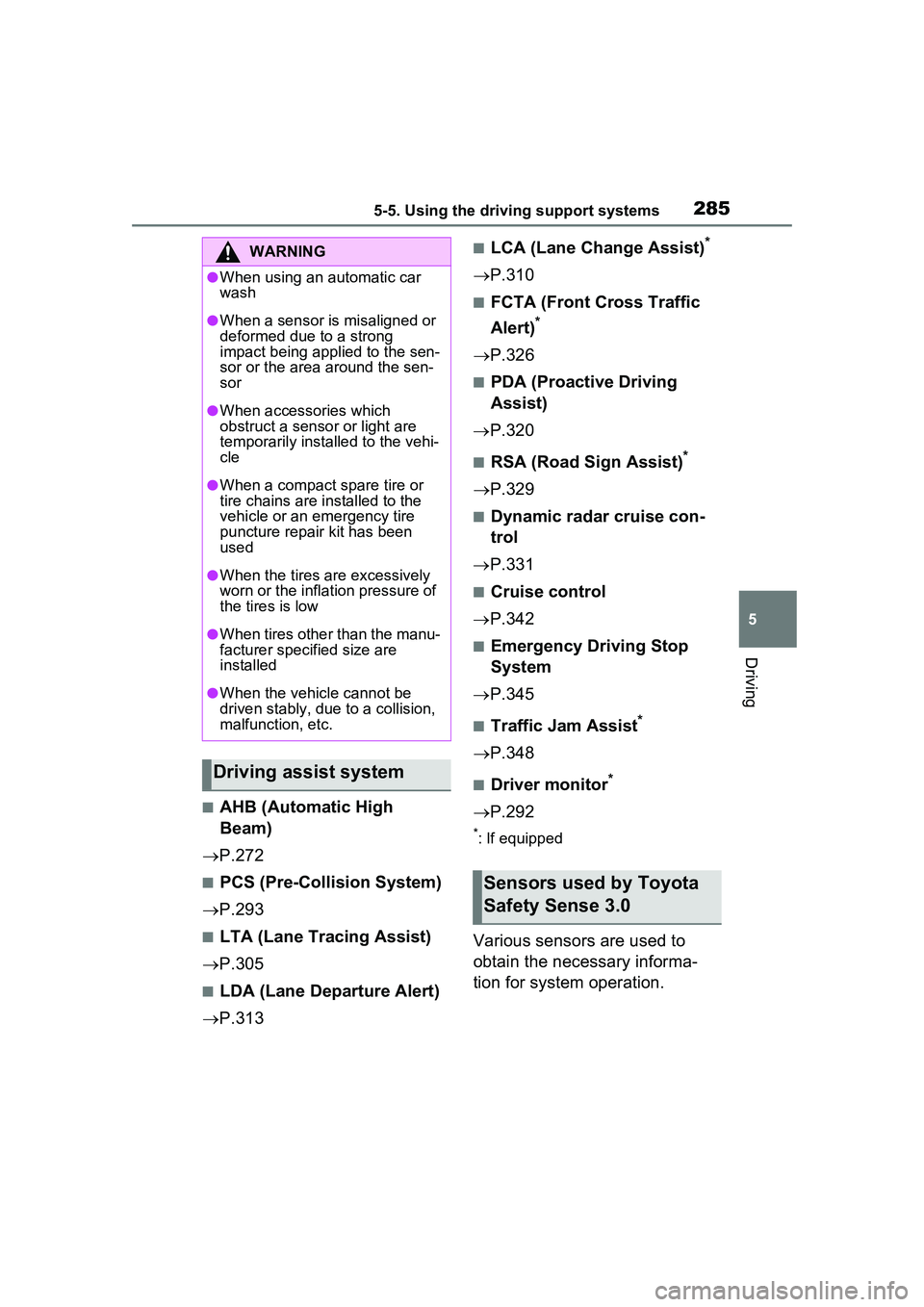
2855-5. Using the driving support systems
5
Driving
■AHB (Automatic High
Beam)
P.272
■PCS (Pre-Collision System)
P.293
■LTA (Lane Tracing Assist)
P.305
■LDA (Lane Departure Alert)
P.313
■LCA (Lane Change Assist)*
P.310
■FCTA (Front Cross Traffic
Alert)
*
P.326
■PDA (Proactive Driving
Assist)
P.320
■RSA (Road Sign Assist)*
P.329
■Dynamic radar cruise con-
trol
P.331
■Cruise control
P.342
■Emergency Driving Stop
System
P.345
■Traffic Jam Assist*
P.348
■Driver monitor*
P.292
*: If equipped
Various sensors are used to
obtain the necessary informa-
tion for system operation.
WARNING
●When using an automatic car
wash
●When a sensor is misaligned or
deformed due to a strong
impact being applied to the sen-
sor or the area around the sen-
sor
●When accessories which
obstruct a sensor or light are
temporarily installed to the vehi-
cle
●When a compact spare tire or
tire chains are installed to the
vehicle or an emergency tire
puncture repair kit has been
used
●When the tires are excessively
worn or the inflation pressure of
the tires is low
●When tires other than the manu-
facturer specified size are
installed
●When the vehicle cannot be
driven stably, due to a collision,
malfunction, etc.
Driving assist system
Sensors used by Toyota
Safety Sense 3.0
Page 286 of 680

2865-5. Using the driving support systems
■Sensors which detect the
surrounding conditions
FrontFront radar sensor
Front camera
Front side radar sensors
*
*: If equipped
Rear
Rear side radar sensors
■Sensors which detect the
driver condition Driver monitor camera
*
*: If equipped
A
B
C
A
WARNING
■To prevent malfunction of the
radar sensors
Observe the following precau-
tions.
Failure to do so may lead to a
radar sensor not operating prop-
erly, possibly leading to an acci-
dent resulting in death or serious
injury.
●Keep the radar sensors and
radar sensor covers clean at all
times.
Clean the front of a radar sensor
or the front or back of a radar sen-
sor cover if it is dirty or covered
with water droplets, snow, etc.
When cleaning the radar sensor
and radar sensor cover, use a soft
cloth to remove dirt so as to not
damage them.
Radar sensor
Radar sensor cover
A
A
B
Page 287 of 680

2875-5. Using the driving support systems
5
Driving
WARNING
●Vehicles with front side radar
sensors: Keep the surrounding
area of the front side radar sen-
sors on the front bumper clean
at all times.
●Do not attach accessories,
stickers (including transparent
stickers), aluminum tape, etc. to
a radar sensor or radar sensor
cover and their surrounding
area.
●Do not subject a radar sensor or
its surrounding area to impact.
If a radar sensor, the front grille,
or front bumper has been sub-
jected to a impact, have the vehi-
cle inspected by your Toyota
dealer.
●Do not disassemble the radar
sensors.
●Do not modify or paint the radar
sensors or radar sensor cover,
or replace them with anything
other than Toyota genuine
parts.
●In the following situations, recal-
ibration of the radar sensors will
be necessary. For details, con-
tact your Toyota dealer.
• When a radar sensor is removed and installed, or
replaced
• When the front bumper or the front grille has been replaced
■To prevent malfunction of the
front camera
Observe the following precau-
tions.
Failure to do so may lead to the
front camera not operating prop-
erly, possibly leading to an acci-
dent resulting in death or serious
injury.
●Always keep the windshield
clean.
• If the windshield is dirty or cov- ered with an o ily film, water
droplets, snow, etc., clean the
windshield.
• Even if a glass coating agent is applied to the windshield, it will
still be necessary to use the
windshield wipers to remove
water droplets, etc. from the
area of the windshield in front of
the front camera.
• If the inner side of the wind- shield where the front camera is
installed is dirty, contact your
Toyota dealer.
●Do not attach stickers (including
transparent stickers) or other
items to the area of the wind-
shield in front of the front cam-
era (shaded area in the
illustration).
Approximately 1.6 in. (4 cm)
Approximately 1.6 in. (4 cm)
A
B
Page 289 of 680

2895-5. Using the driving support systems
5
Driving
■Precautions for use
It is necessary to enter a connected
services contract, provided by
Toyota, to use these functions. For
details, contact your Toyota dealer.
●LCA (Lane Change Assist)
P.310
●Radar Cruise Control: Extended
resume time
P.331
●Traffic Jam Assist
P.348
■Situations in which the sensors
may not operate properly
●When the height or inclination of
the vehicle has been changed due
to modifications
●When the windshield is dirty,
fogged up, cracked or damaged
●When the ambient temperature is
high or low
●When mud, water, snow, dead
insects, foreign matter, etc., is
attached to the front of the sensor
●When in inclement weather such
as heavy rain, fog, snow, or a
sandstorm
●When water, snow, dust, etc. is
thrown up in front of the vehicle, or
when driving through mist or
smoke
●When the headlights are not illu-
minated while driving in the dark,
such as at night or when in a tun-
nel
●When the lens of a headlight is
dirty and illumination is weak
●When the headlights are mis-
aligned
●When a headlight is malfunction-
ing
●When the headlights of another
vehicle, sunlight, or reflected light
shines directly into the front cam-
era
●When the brightness of the sur-
rounding area changes suddenly
●When driving near a TV tower,
broadcasting station, electric
power plant, radar equipped vehi-
cles, etc., or other location where
WARNING
●Do not subject the driver moni-
tor camera or its surrounding
area to strong impact.
If subjected to a strong impact,
the driver monitor camera may
move out of alignment and the
driver may no longer be detected
correctly. In this case, have the
vehicle inspected by your Toyota
dealer.
●Do not disassemble or modify
the driver monitor camera.
●Do not attach accessories,
stickers (including transparent
stickers), etc. to the driver moni-
tor camera or its surrounding
area.
●Do not allow the driver monitor
camera or its surrounding area
to get wet.
●Do not cover the driver monitor
camera or place anything in
front of it.
●Keep the lens of the driver mon-
itor camera free from damage.
●Do not touch the lens of the
driver monitor came ra or allow it
to become dirty.
When there is dirt or fingerprints
on the camera lens, clean it with a
dry, soft cloth so as to not mark or
damage it.
●When cleaning the lens, do not
use detergents or organic sol-
vents that may damage plastic.
Page 293 of 680
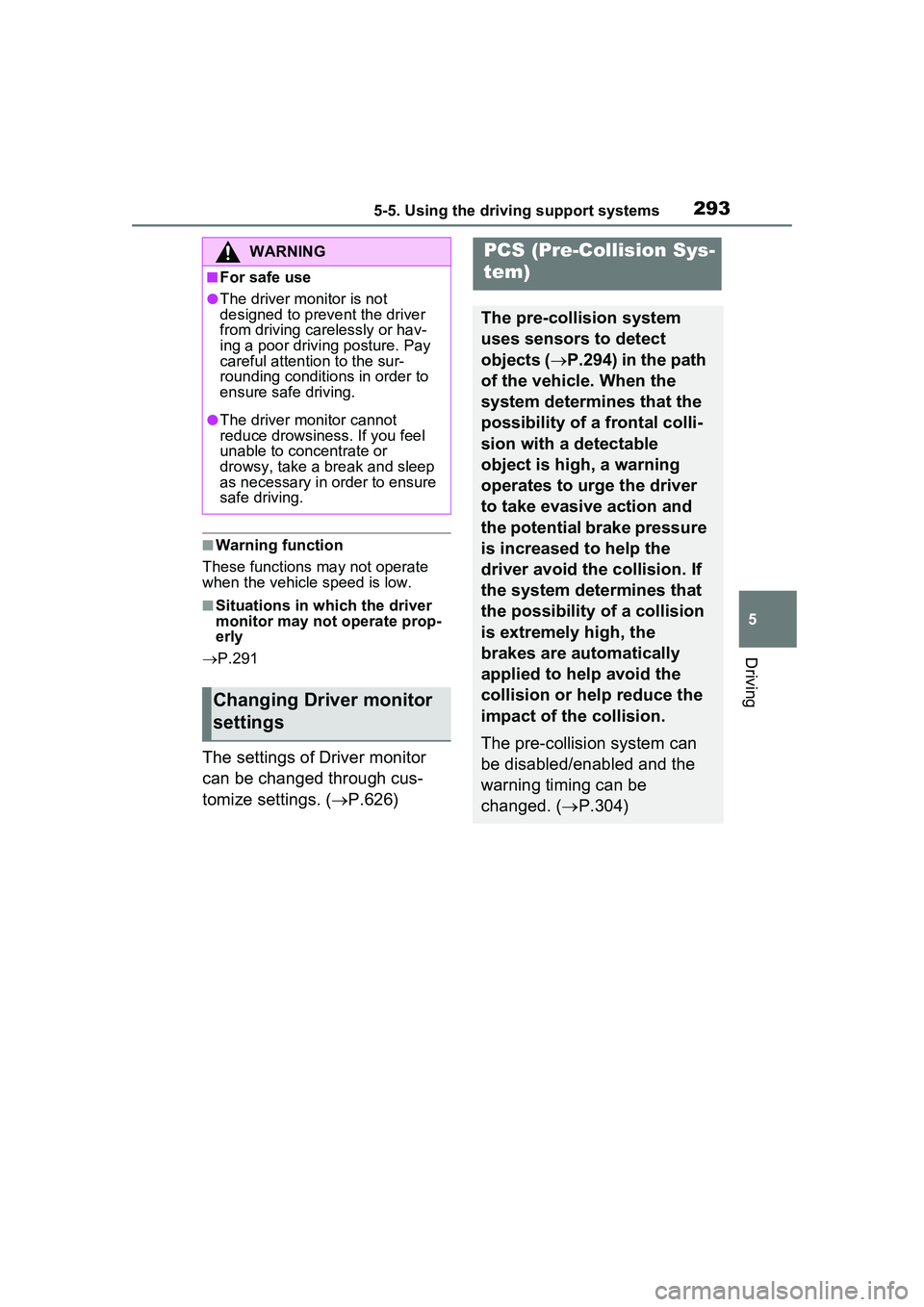
2935-5. Using the driving support systems
5
Driving
■Warning function
These functions may not operate
when the vehicle speed is low.
■Situations in which the driver
monitor may not operate prop-
erly
P.291
The settings of Driver monitor
can be changed through cus-
tomize settings. ( P.626)
WARNING
■For safe use
●The driver monitor is not
designed to prevent the driver
from driving carelessly or hav-
ing a poor driving posture. Pay
careful attention to the sur-
rounding conditions in order to
ensure safe driving.
●The driver monitor cannot
reduce drowsiness. If you feel
unable to concentrate or
drowsy, take a break and sleep
as necessary in order to ensure
safe driving.
Changing Driver monitor
settings
PCS (Pre-Collision Sys-
tem)
The pre-collision system
uses sensors to detect
objects ( P.294) in the path
of the vehicle. When the
system determines that the
possibility of a frontal colli-
sion with a detectable
object is high, a warning
operates to urge the driver
to take evasive action and
the potential brake pressure
is increased to help the
driver avoid the collision. If
the system determines that
the possibility of a collision
is extremely high, the
brakes are automatically
applied to help avoid the
collision or help reduce the
impact of the collision.
The pre-collision system can
be disabled/enabled and the
warning timing can be
changed. ( P.304)
Page 309 of 680
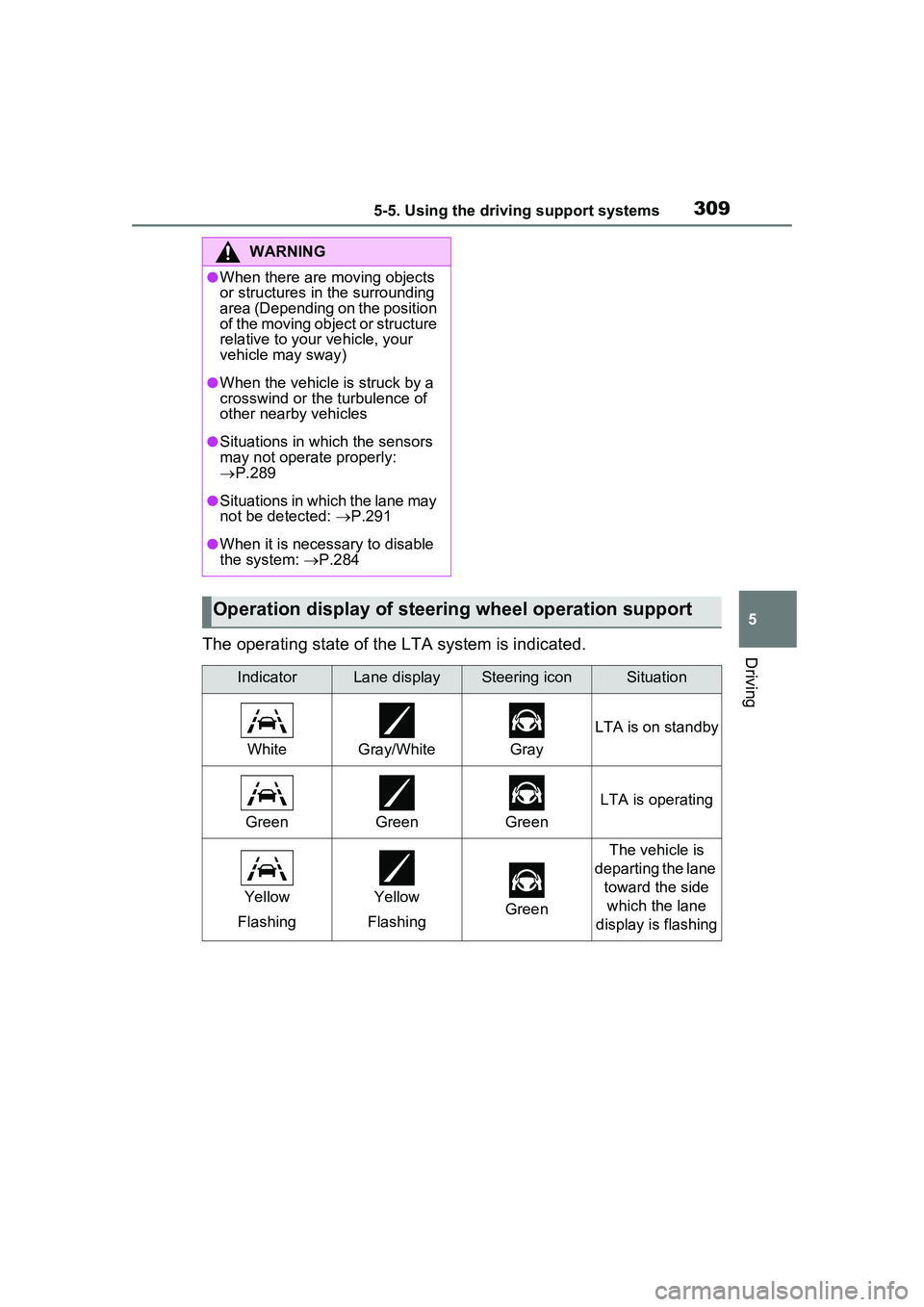
3095-5. Using the driving support systems
5
DrivingThe operating state of the LTA system is indicated.
WARNING
●When there are moving objects
or structures in the surrounding
area (Depending on the position
of the moving object or structure
relative to your vehicle, your
vehicle may sway)
●When the vehicle is struck by a
crosswind or the turbulence of
other nearby vehicles
●Situations in which the sensors
may not operate properly:
P.289
●Situations in which the lane may
not be detected: P.291
●When it is necessary to disable
the system: P.284
Operation display of steering wheel operation support
IndicatorLane displaySteering iconSituation
WhiteGray/WhiteGray
LTA is on standby
GreenGreenGreen
LTA is operating
Yellow
FlashingYellow
FlashingGreen
The vehicle is
departing the lane toward the side which the lane
display is flashing
Page 317 of 680

3175-5. Using the driving support systems
5
Driving
The operating state of the lane departure alert function and steering
assist operation of the lane departure prevention function are indi-
cated.
Except for Puerto Rico
WARNING
●When the boundary between
the asphalt and grass, soil, etc.,
or structures, such as a curb,
guardrail, etc. is not clear or
straight
●When the vehicle is struck by a
crosswind or the turbulence of
other nearby vehicles
●Situations in which the lane may
not be detected: P.291
●Situations in which the sensors
may not operate properly:
P.289
●Situations in which some or all
of the functions of the system
cannot operate: P.291
●When it is necessary to disable
the system: P.284
Displays and system operation
IndicatorLane displaySteering iconCondition
Not illuminatedNot illuminatedNot illuminatedSystem disabled
WhiteGray
Not illuminated
Lane lines are not
detected by the system
WhiteWhite
Not illuminated
Lane lines are
detected by the system
Page 320 of 680
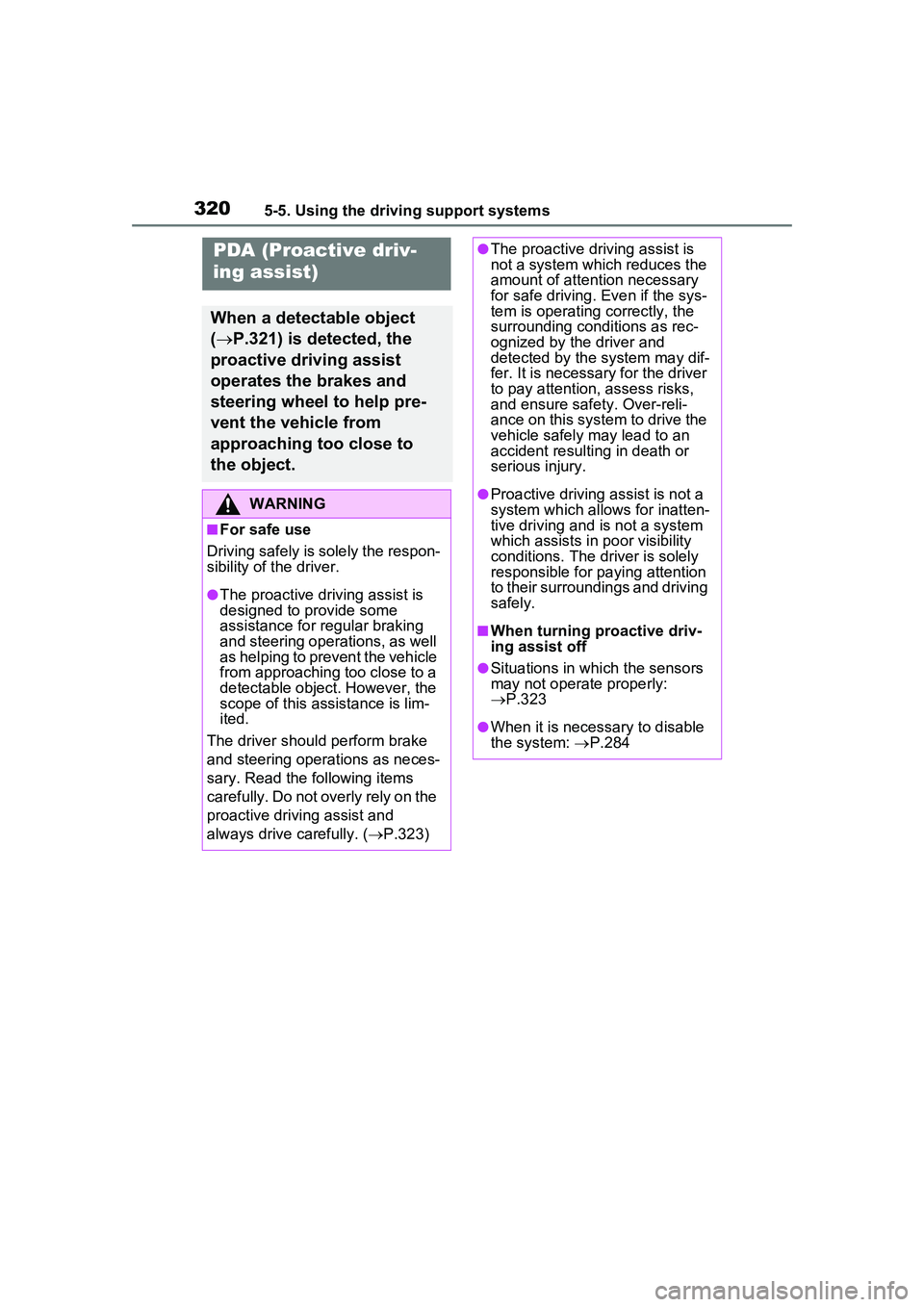
3205-5. Using the driving support systems
PDA (Proactive driv-
ing assist)
When a detectable object
(P.321) is detected, the
proactive driving assist
operates the brakes and
steering wheel to help pre-
vent the vehicle from
approaching too close to
the object.
WARNING
■For safe use
Driving safely is solely the respon-
sibility of the driver.
●The proactive driving assist is
designed to provide some
assistance for regular braking
and steering operations, as well
as helping to prevent the vehicle
from approaching too close to a
detectable object. However, the
scope of this assistance is lim-
ited.
The driver should perform brake
and steering operations as neces-
sary. Read the following items
carefully. Do not overly rely on the
proactive driving assist and
always drive carefully. ( P.323)
●The proactive driving assist is
not a system which reduces the
amount of attention necessary
for safe driving. Even if the sys-
tem is operating correctly, the
surrounding conditions as rec-
ognized by the driver and
detected by the system may dif-
fer. It is necessary for the driver
to pay attention, assess risks,
and ensure safety. Over-reli-
ance on this system to drive the
vehicle safely may lead to an
accident resulting in death or
serious injury.
●Proactive driving assist is not a
system which allows for inatten-
tive driving and is not a system
which assists in poor visibility
conditions. The driver is solely
responsible for paying attention
to their surroundings and driving
safely.
■When turning proactive driv-
ing assist off
●Situations in which the sensors
may not operate properly:
P.323
●When it is necessary to disable
the system: P.284
Page 328 of 680
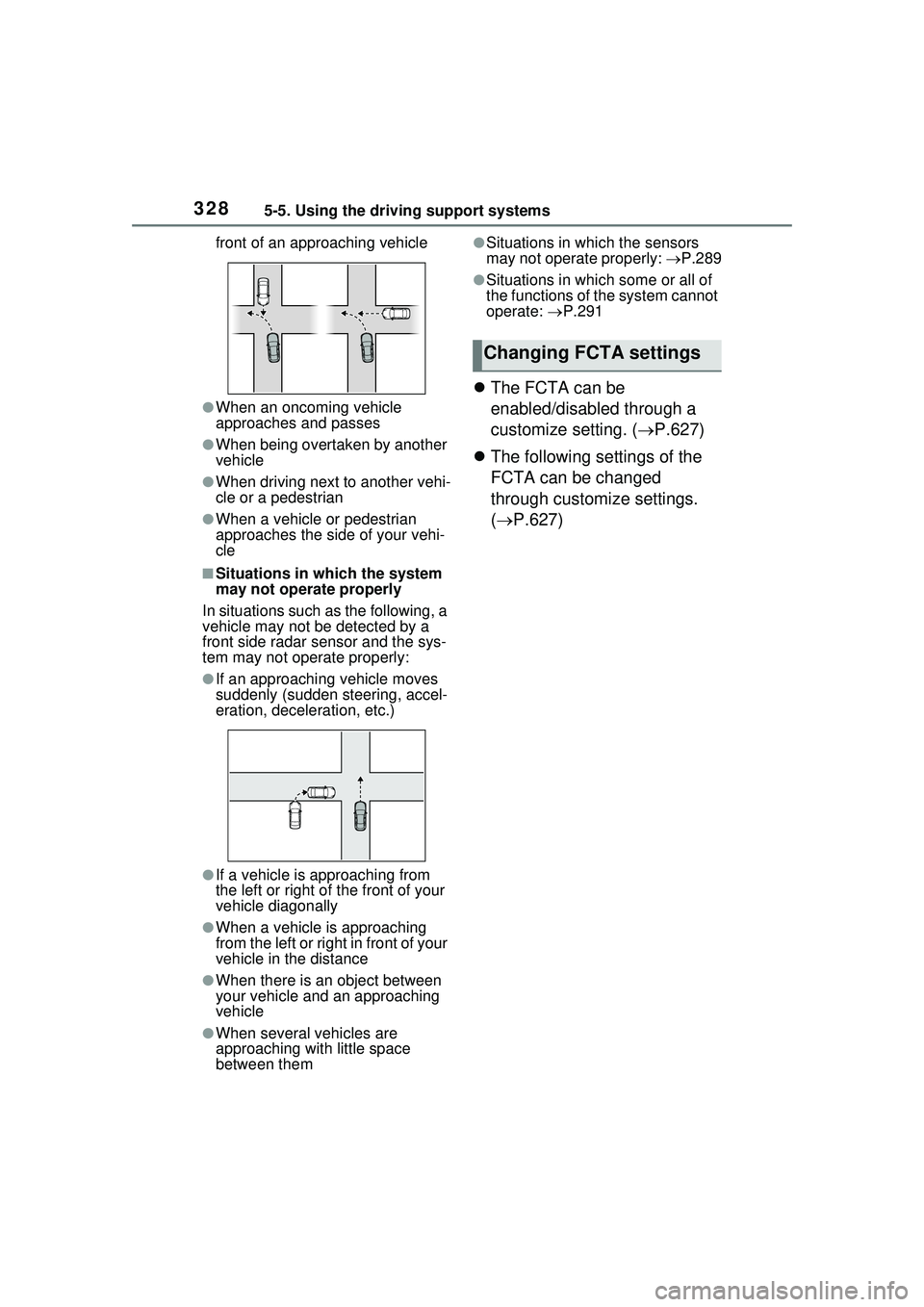
3285-5. Using the driving support systems
front of an approaching vehicle
●When an oncoming vehicle
approaches and passes
●When being overtaken by another
vehicle
●When driving next to another vehi-
cle or a pedestrian
●When a vehicle or pedestrian
approaches the side of your vehi-
cle
■Situations in which the system
may not operate properly
In situations such as the following, a
vehicle may not be detected by a
front side radar sensor and the sys-
tem may not operate properly:
●If an approaching vehicle moves
suddenly (sudden steering, accel-
eration, deceleration, etc.)
●If a vehicle is approaching from
the left or right of the front of your
vehicle diagonally
●When a vehicle is approaching
from the left or right in front of your
vehicle in the distance
●When there is an object between
your vehicle and an approaching
vehicle
●When several vehicles are
approaching with little space
between them
●Situations in which the sensors
may not operate properly: P.289
●Situations in which some or all of
the functions of the system cannot
operate: P.291
The FCTA can be
enabled/disabled through a
customize setting. ( P.627)
The following settings of the
FCTA can be changed
through customize settings.
( P.627)
Changing FCTA settings
Page 329 of 680
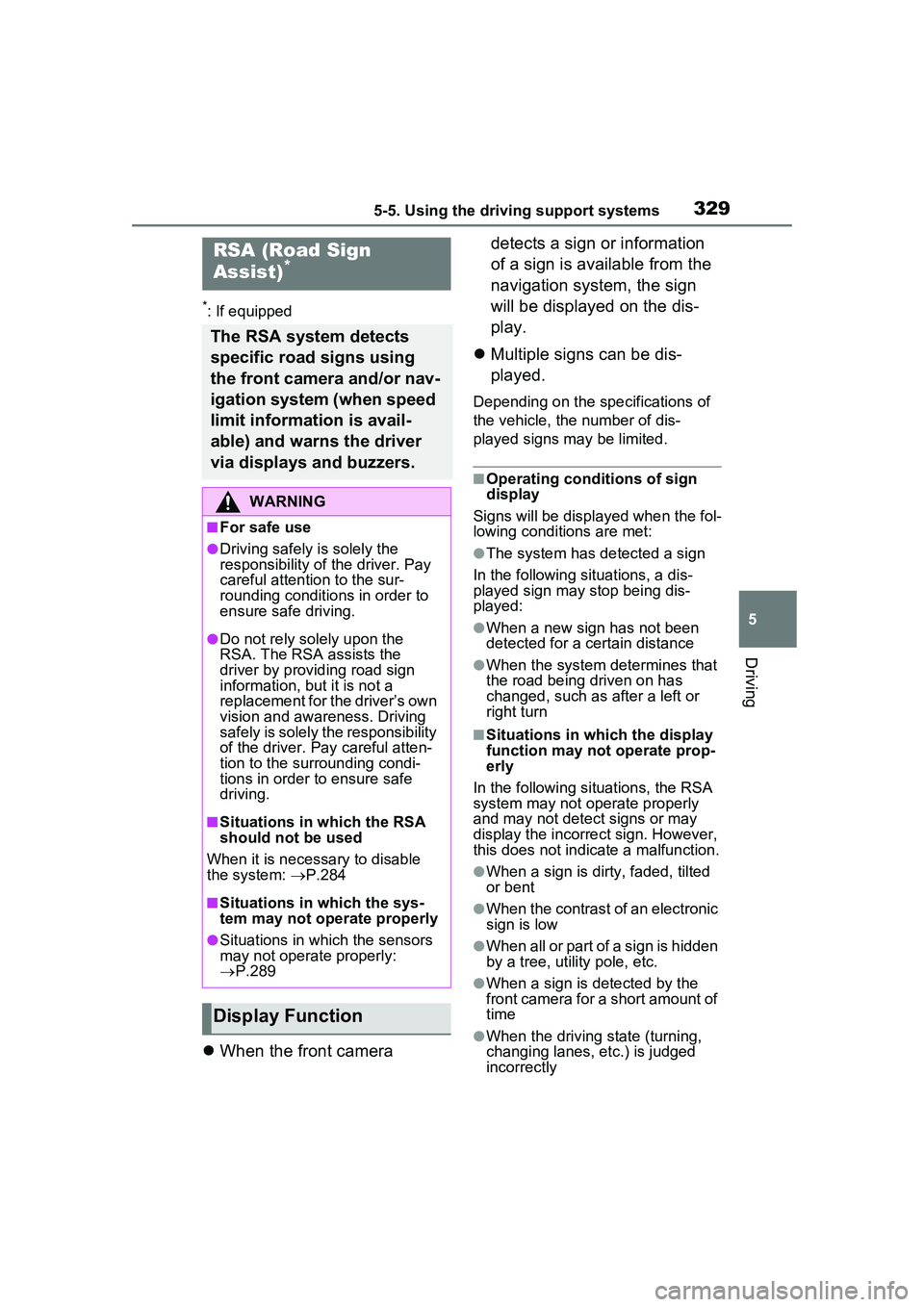
3295-5. Using the driving support systems
5
Driving
*: If equipped
When the front camera detects a sign or information
of a sign is available from the
navigation system, the sign
will be displayed on the dis-
play.
Multiple signs can be dis-
played.
Depending on the specifications of
the vehicle, the number of dis-
played signs may be limited.
■Operating conditions of sign
display
Signs will be displayed when the fol-
lowing conditions are met:
●The system has detected a sign
In the following situations, a dis-
played sign may stop being dis-
played:
●When a new sign has not been
detected for a certain distance
●When the system determines that
the road being driven on has
changed, such as after a left or
right turn
■Situations in which the display
function may not operate prop-
erly
In the following situations, the RSA
system may not operate properly
and may not detect signs or may
display the incorrect sign. However,
this does not indicate a malfunction.
●When a sign is dirty, faded, tilted
or bent
●When the contrast of an electronic
sign is low
●When all or part of a sign is hidden
by a tree, utility pole, etc.
●When a sign is detected by the
front camera for a short amount of
time
●When the driving state (turning,
changing lanes, etc.) is judged
incorrectly
RSA (Road Sign
Assist)*
The RSA system detects
specific road signs using
the front camera and/or nav-
igation system (when speed
limit information is avail-
able) and warns the driver
via displays and buzzers.
WARNING
■For safe use
●Driving safely is solely the
responsibility of the driver. Pay
careful attention to the sur-
rounding conditions in order to
ensure safe driving.
●Do not rely solely upon the
RSA. The RSA assists the
driver by providing road sign
information, but it is not a
replacement for the driver’s own
vision and awareness. Driving
safely is solely the responsibility
of the driver. Pay careful atten-
tion to the surrounding condi-
tions in order to ensure safe
driving.
■Situations in which the RSA
should not be used
When it is necessary to disable
the system: P.284
■Situations in which the sys-
tem may not operate properly
●Situations in which the sensors
may not operate properly:
P.289
Display Function